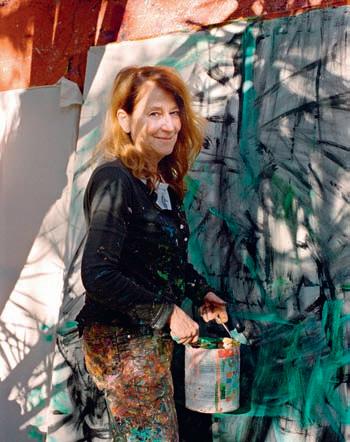
4 minute read
Profile The art of Vivien Suter, inspired by her Guatemalan home, comes to the UK
Life cycle

Inspired by the natural beauty of Guatemala, Vivien Suter’s abstract art finally gets a showing in the UK
Words / Philomena Epps
In the early 1980s, the Swiss-Argentine artist Vivian Suter left her life in Basel, and the art world, to begin a long, solitary driving trip through North and Central America. In 1982, she arrived in Panajachel, a small village in the heart of the rainforest on the north shore of Lake Atitlán in Guatemala, which became her home. Suter lives on a former coffee plantation with her mother Elisabeth Wild, also an artist. Her studio is comprised of a series of open-air wooden structures, which are exposed to the natural elements, situated within the overgrown tropical flora and fauna, against the vivid backdrop of volcanoes and mountains.
Inspired by the powerful intensity of the surrounding landscape – the changing seasons, the colours, the smell of flowers, the sounds of birds – Suter’s paintings are rich evocations of the local, lush vegetation, with the organic shapes and motifs treading an ambiguous line between figuration and abstraction.

Suter’s paintings – which are the subject of two major upcoming shows in the UK – have no hierarchy: the natural world is both her subject and her medium, an active participant in the creation of the work. After Guatemala was struck by two hurricanes in 2005 and 2010, destroying parts of Panajachel and flooding Suter’s studio, damaging her work, she began to use the mud as a way of repurposing the paintings. She now leaves all of her raw, untreated canvases outside, often integrating the earth, as well as volcanic and botanical matter, into her compositions. Humidity or light might change the paint’s colour or texture; leaves or branches become congealed in the drying pigment; and marks from animals and insects, such as dog paw-prints, are left in Above Unstretched canvases hang in the open air as part of Suter’s Nisyros installation in Athens Image by Stakis Mamalakis
Previous page A collaboration with Suter’s mother Elisabeth Wild, La Canícula was shown in Toronto in 2018 Image by Toni Hafkenscheid
tact. Suter harnesses these processes, collecting and using rainwater to wet glue or mix paints.

“Rather than merely concentrating on the representation of nature, rendered realistically or achieved by abstracting and estranging natural shapes and colours, Suter became witness to the gradual destruction, decay and regeneration of nature,” writes the curator and critic Adam Szymczyk in a recent monograph dedicated to her work. “Her paintings are testaments to their own destruction, rather than objects made to be looked at or to last.”
In 2014, Szymczyk, at that time the director of Kunsthalle in Basel, had brought Suter back to the city for a solo exhibition, and included her work in his edition of art show Documenta 14, which took place in Athens and Kassel. It led to a surge of interest throughout Europe and the US, with major exhibitions being hosted in Boston, Mexico City, New York, Los Angeles and Toronto. The first solo display of Suter’s work in the UK will be shown at Tate Liverpool from December 2019 until March 2020. The canopy of colourful hanging canvases Nisyros (Vivian’s Bed) from 2016-17 is a room-sized installation that was originally shown in Kassel.
Suter’s forthcoming exhibition at London’s Camden Arts Centre, on from January to April 2020, is on a larger scale, and will be a mixture of new and existing mixed media works. Suter’s practice has an intense physical presence. She is a prolific maker, often intuitively reimagining or repurposing former paintings in order to create dense and overlapping installations. Her canvases, sometimes hung like curtains, will inundate the gallery’s walls, floors and ceilings.

In addition to showing inside the gallery, she will also be installing work in its sizeable garden, where the canvases will be vulnerable to the conditions not of Guatemala but of London’s winter weather: the potential of wind, snow, and rain. This contrast between the British outdoors and the verdant tropical heat of her studio, where the paintings were originally made, is a key part of the life cycle of her work, and her unique site-specific practice. Viewing the work becomes an immersive sensory and temporal experience. Courtesy of the artist & Gladstone Gallery, New York & Brussels
Above Left to right: Vivien Suter in Guatemala; an untitled mixedmedia work that is being shown as part of Camden Arts Centre’s show Right image by David Regen

ARCHITECTURE Surveying the built environment











